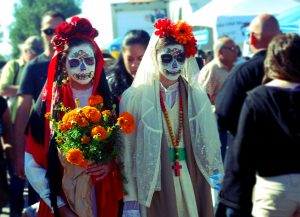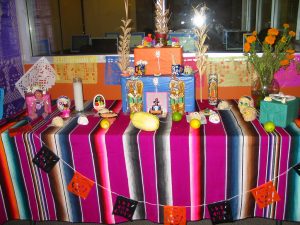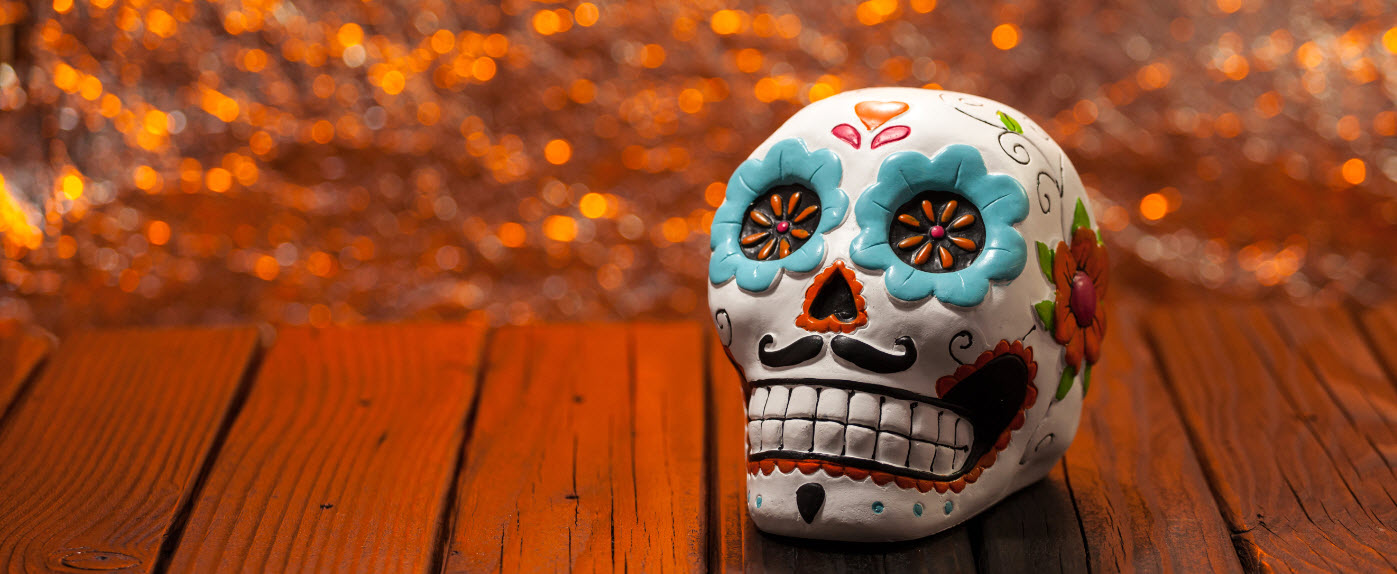
| By Gale Staff |
Día de Muertos, Day of the Dead, is observed in Mexico on 2 November, the final day of a celebration that begins on Halloween. Though practices differ from city to city, the holiday is generally an opportunity to honor deceased loved ones, for whom families prepare ofrendas, or altars, which are decorated with candy skulls, marigolds, and incense. As the day proceeds, observance often takes place alongside revelry, with eating, drinking, and costumed dancing in cemeteries and in the streets. With its distinctive practices and macabre, often surreal, imagery, the holiday has been mined by literary authors for its thematic power.
Readers interested in the creation of a proper ofrenda can refer to Delia’s Song, the semi-autobiographical first novel of Mexican American writer Lucha Corpi, treated in Contemporary Literary Criticism 418. That work describes the transmission of cultural traditions among Mexican women. As Delia prepares an altar along with her Aunt Marta:
They made the traditional candy skulls and the bread for the dead while Jack [Marta’s huband] made the shelves…. They made the papel picado cutouts and Delia glued them on long sticks to be installed at the ends of each shelf. There were also tiny pictures of Kennedy and Pope John next to a medal of the Sacred Heart; two embroideries Marta had made years ago showing the heads of Tiburcio Vásquez and Joaquín Murrieta hung on each side of the picture of the Virgen de Guadelupe. Marta was a great admirer of both folk heroes, and their feats and exploits were part of her storytelling repertoire.

According to scholar Carol E. Pearson, “in this description, the detail and the work of the every day is tied together with much of Delia’s heritage—the culture, the tradition and the (his)stories of both her family and her people.”
The holiday becomes an occasion for personal transformation in Terry Tempest Williams’s 1991 memoir Refuge, which is the subject of an entry in Contemporary Literary Criticism 362. The book explores the endangered ecology of the Bear River Migratory Bird Refuge on Utah’s Great Salt Lake in conjunction with the author’s personal narrative of her mother’s death from cancer. Late in the story, seeking to cope with her loss, Williams writes that she “needed a ritual, a celebration to move me from death to life.” She goes to Mexico to take part in the Day of the Dead. There, she visits a church and shares remembrances of deceased relatives among strangers. Later, she purchases a traditional mask and joins the festivities:
Wearing my owl mask, I danced in the cobblestone streets. Bonfires lit every corner. Townsfolk circled them warming their hands. Tequila poured through the gutters. In one glance, I saw both lovers and murderers kissing and knifing each other against doors. Puppet shows were performed in the plaza as firecrackers exploded at our feet. Costumed children paraded through the village, carrying illuminated gourds as lanterns. All night long there is the relentless clamouring of bells, and the baying of dogs.
According to critic A. James Wohlpart, “this ceremony, as an act of restoring Williams to herself by moving her through her grief, allows her to move beyond the worldview handed her by Western civilization and to engage an alternate worldview.” Returning from Mexico, she brings home petals from a marigold, her mother’s favorite; on a canoe trip with her husband, she sprinkles them on the lake as a memorial.
For many, the Day of the Dead is also an occasion for boozing. Among the grimmest treatments of that subject is found in Malcolm Lowry’s complex and allusive 1947 masterpiece, Under the Volcano, which is discussed in Twentieth-Century Literary Criticism 6, 40, and 275. The novel—set almost entirely on 2 November in Quauhnahuac, Mexico—chronicles the downfall of Geoffrey Firmin, who has lost his job as a British Consul and has been abandoned by his young American wife. Over the course of the narrative, he drinks severely and is finally killed in a case of mistaken identity. Critic Dale Edmonds called the novel “a drinker’s paradise,” noting that “references to drinks, drinking, drinking places, and/or drunkenness occur on 252 of the 377 pages.” His tally of the protagonist’s consumption on the Day of the Dead totaled some sixty-one ounces of 80-90 proof alcohol—a stupefying and seemingly coma-inducing amount. And yet, Edmonds admitted, despite the self-destructiveness of his behavior, “that the Consul’s plunge has its moments of bliss and glory and that drink is the Consul’s mistress, his muse, his God, no matter what dark fate awaits him. Who is to say that on the Day of the Dead he does not realize his destiny through his long day’s drinking?”
Perhaps the best statement of the deeply ambivalent nature of the holiday comes from Lowry’s own observation, quoted in Ronald G. Walker’s essay, “The ‘Barranca’ of History”:
The Mexicans laugh at death; that does not mean they don’t take it seriously. It is perhaps only by the possession of a tragic sense of life such as theirs that joy and mirth find their place: it is an attitude that testifies to the dignity of man.
Ready to jump into your own Día de Muertos research with our Literature Criticism Online database? Request a trial today >>Air Jordan 1 Mid Black White Shoes Best Price 554724-113 – Buy Best Price Adidas&Nike Sport Sneakers

